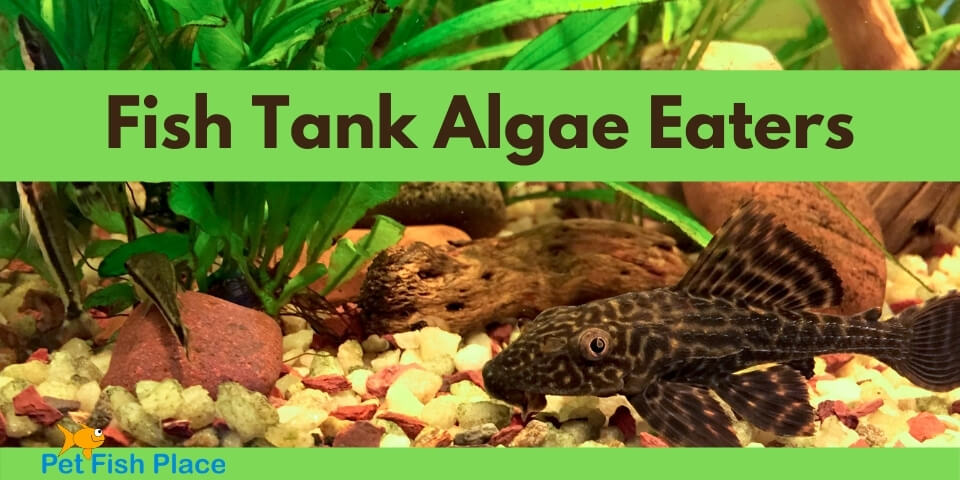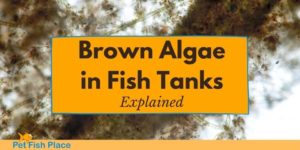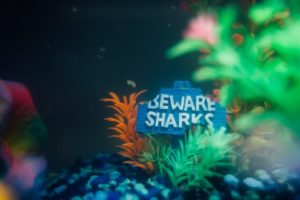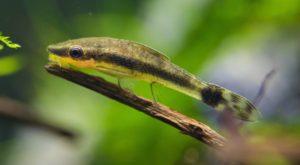Sharing is caring!
Fish tank algae eaters are a common category of fish, snails, and shrimp that people in the hobby buy in order to keep their tanks clean and algae-free. Unfortunately, the fish in this category are often bought without paying attention to their needs and put in aquariums that are not suitable for their needs. This article will give you a deeper understanding of the most known algae eaters in order to help you become a successful aquarium keeper.
It’s important to specify a general rule that applies to all categories of algae eaters. They need to be fed like any other animal and cannot live only eating algae and leftovers in the tank.
Algae eating fish
Common Pleco (Hypostomus Plecostomus)
Plecostomus (commonly called plecos) are also called “Suckermouth Catfish”, they can grow up to 24 inches in length, so it’s important to consider their future size when buying one of these.
Minimum aquarium size: 125 Gallons
Water parameters: 72° – 82°F, 6.5 – 7.5 pH
The aquarium needs to have a lot of woods and rocks that provide hiding.
They are relatively passive towards other fish but can be territorial and aggressive towards members of their own species. Having a larger aquarium would help prevent that. This makes them compatible with almost any other fish.
In terms of food, they are very particular and will eat a wide variety of food. There are also plenty of Pleco specific foods available on the market.
Plecos can be a difficult species to breed in an aquarium. However, with the right set-up, it is possible.
Bushy Nose Pleco (Ancistrus sp.)
Ancistrus is a really common “Sucker Fish” that gets its common name, Bushy Nose Pleco, from its appendages found on its mouth and nose. Compared to common Plecos, Ancistrus are smaller, growing only up to 5 inches in length, and are much easier to breed in an aquarium.
Minimum aquarium sizes: 30 Gallons
Water parameters: 74° – 79°F, 6.5 – 7.4 pH
As Plecos, they are really passive but prove to be aggressive towards other Bushy Nose Plecos. They are great with most other fish.
They will eat pretty much anything that is available.
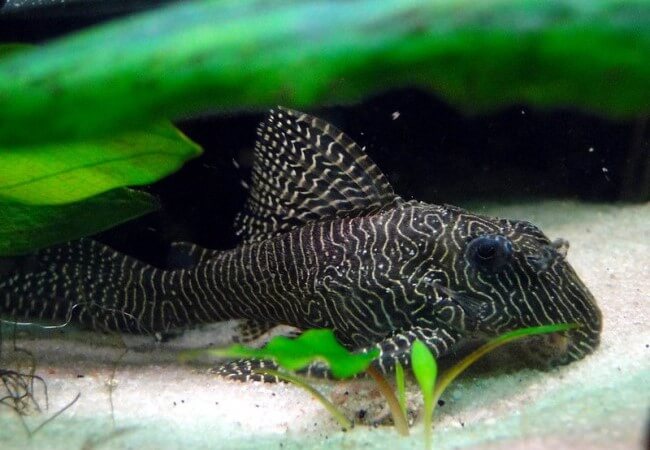
Otocinclus Catfish (Otocinclus vestitus)
Otocinclus, or Oto Cats, are the smallest species of algae eater fish in the hobby, getting up to 4 inches maximum in length. They are very shy and prefer to be in groups of at least 6 or 8.
Otocinclus are very sensitive to bad water conditions and need to be introduced only in mature aquariums with nitrates lower than 20ppm.
Minimum aquarium size: 10 Gallons
Water parameters: 74° – 79°F, 6.8 – 7.5 pH
The ideal aquarium needs to be strongly planted and with a constant algae growth that Otocinclus will use as food. They are very peaceful and shy, for this reason, they should be ideally kept in a community aquarium with other non-aggressive fishes.
Besides algae, they can also eat flake foods and algae wafers.
Difficult to breed in an aquarium.
Chinese Algae Eater (Gyrinocheilos aymonieri)
Chinese Algae Eaters are one of the common fishes purchased in terms of algae control, they eat a wide range of algae including Black Beard. They can grow up to 10 inches in length and can become aggressive as they mature. They are also known to stop eating algae as they become adults though.
Minimum aquarium size: 30 Gallons
Water parameters: 74° -79°F, 6.8 – 7.4 pH
They need clean and highly oxygenated water. The ideal aquarium should be heavily planted with rocks and wood creating shadow areas.
Chinese Algae Eaters are a peaceful species when young and can be kept with any kind of fish. However, they can become territorial as they age.
Besides algae, they also eat dry food, and really appreciate fruit, spinach and peas.
Impossible to breed in an aquarium.

Algae eating snails
Mystery Snail (Pomacea sp.)
Mystery snails are really common and can be found in any aquarium shop. They are detrivores and will eat different kinds of algae, leftover food, and decaying plant matter. These snails can grow up to 1 1/2″ in diameter. Use the rule of 1 snail to 5 gallons to avoid overcrowding when adding multiples.
Minimum aquarium size: 10 Gallons.
Water parameters: 68°-84°F, 7.5 – 8.4 pH
Low levels of pH can start to dissolve the shells of the snails making them vulnerable to other fish.
They are compatible with most fish except for aggressive ones such as Oscars and Cichlids. Also, avoid putting them in tanks with puffers or loaches.
They will naturally reproduce in your tanks without any help.
Nerite Snail (Neritina sp.)
Nerite snails are a widespread species in the hobby. They are incredible algae eaters and come in a variety of colors and patterns. These snails can grow up to 1″ in diameter.
Minimum aquarium size: 5 Gallons
Water parameters: 68°-84°F, 6.5 – 8.4 pH
Low levels of pH can start to dissolve the shells of the snails making them vulnerable to other fishes. However, Nerita tend to do better than Mystery Snails.
Nerites are compatible with most any fish except larger aggressive species or ones that feed on snail.
Nerite snails will not reproduce in a freshwater aquarium.
Algae eating shrimp
Cherry Shrimp (Neocaridina davidi)
Cherry shrimp are probably the most popular ornamental shrimp in the hobby. They are really small and grow to about 1 1/2″ in length. They should be kept in groups of at least 6 in order to show their best possible behavior.
Minimum aquarium size: 10 Gallons
Water parameters: 60°-80°F, 6.5 – 7.0 pH
Prepare a densely planted aquarium in order to provide hiding, especially important if kept with other fish. They can be kept only with small fish like Endlers or Rasboras otherwise they will be seen as live food.
These animals are detrivores and eat everything. If kept in a monospecific aquarium, specific shrimp food is recommended to further improve coloration and activity.
Cherry shrimp will naturally breed in your aquarium if they don’t feel threatened by other fish.
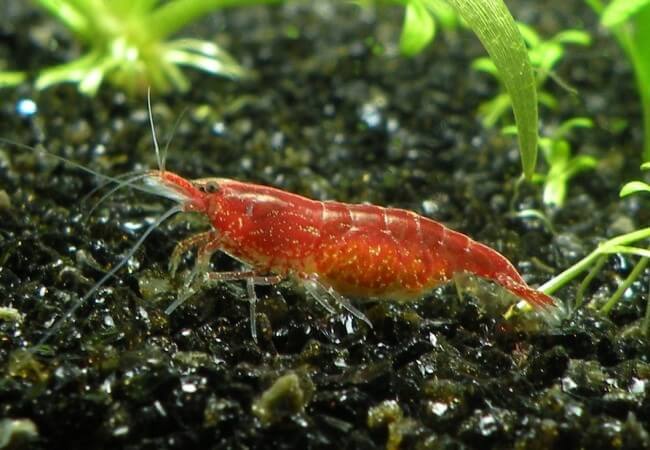
Amano Shrimp (Caridina japonia)
Amano shrimp are the best algae-eaters among shrimp species. They are bigger than Neocaridina and can grow up to 2″ in length. They should be kept in groups of at least 6 to help reduce any dominant behaviour among them during feeding.
Minimum aquarium size: 10 Gallons
Water parameters: 65°-80°F, 6.2 – 7.0 pH
Provide them hiding spots using plants, woods, and rocks. They are peaceful towards other fishes but are can be aggressive towards other species of shrimps, especially during feeding.
Amano shrimps should not be kept with large and aggressive fish.
They will eat any kind of food and algae. They are also very difficult to breed.
Algae eaters summary
When it comes to controlling algae in your aquarium, these are some great options. There are many other alternatives that weren’t listed but these are the most popular and are a great place to start.
Just remember, using algae eaters in your aquarium should not be used in place of regular tank maintenance. While shrimp and snails will scavenge for leftovers and algae, they do not eat fish poop and therefore will not help control your nitrates. Seems like an odd thing to point out, but this is a common misconception among new aquarists.
Sharing is caring!

